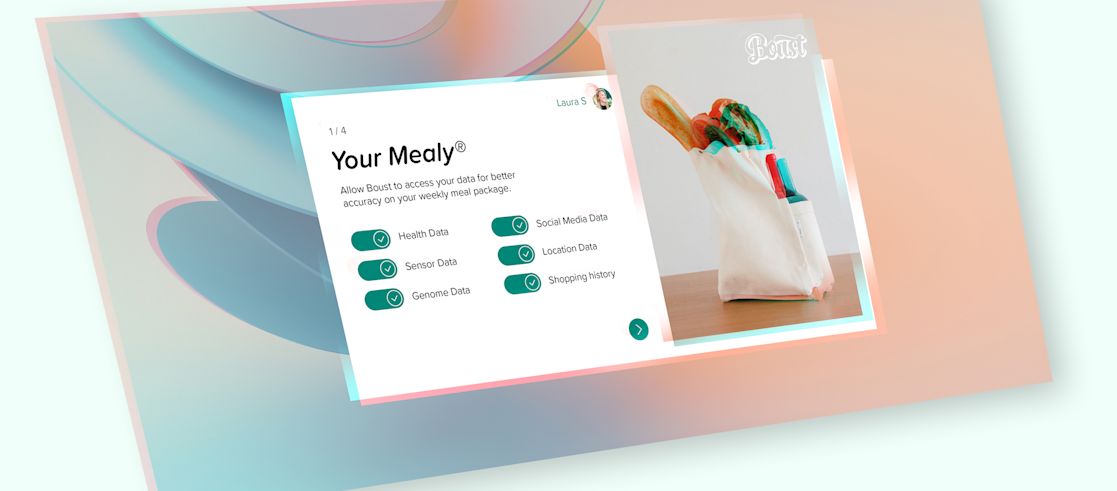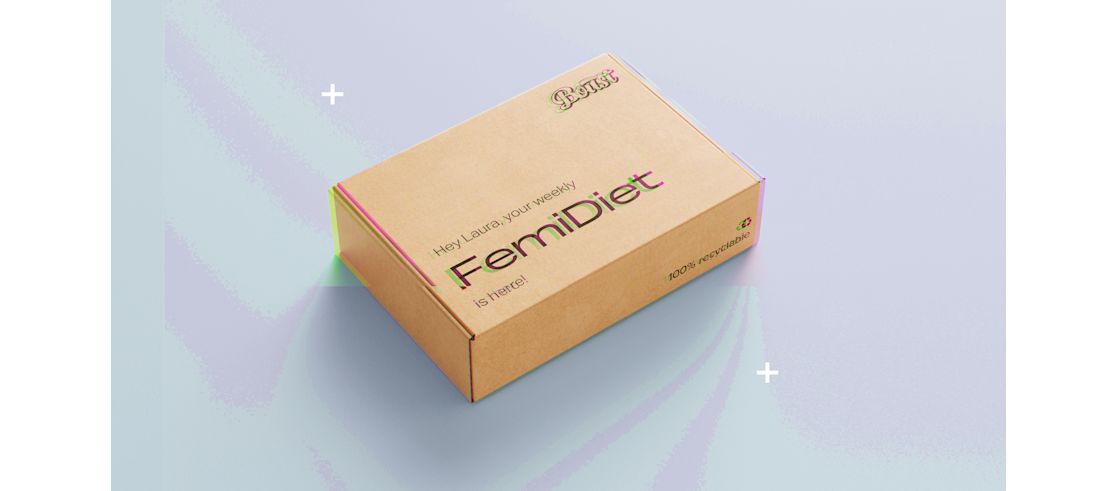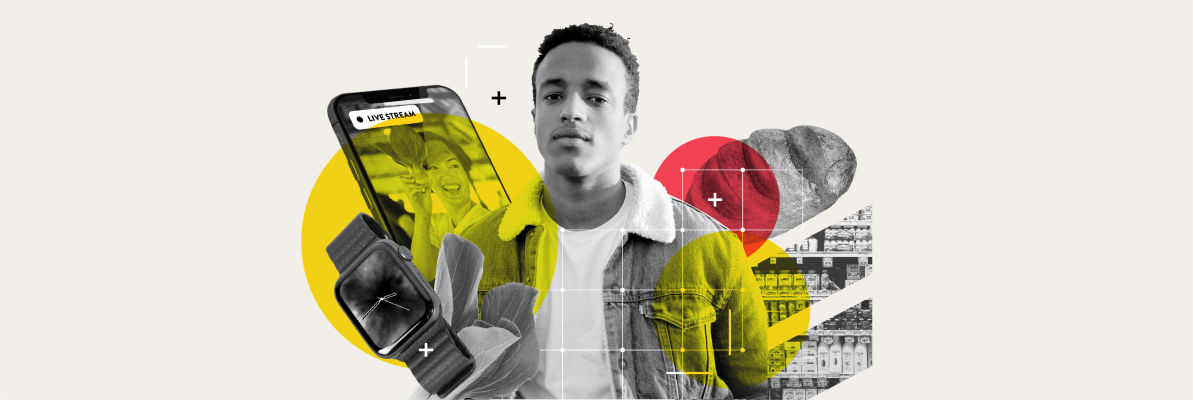
Developing optimized groceries-as-a-service systems
Would you provide access to your personal data to receive custom grocery deliveries that keep you healthy and happy? In this version of the future, most consumers order their groceries as a data-based service. Whoever gets last-mile delivery right will rule the ecosystem.
Hello, nice to meet you; my name is Laura. For 17 years, I’ve worked as a growth consultant for an international NGO. It’s challenging work with long hours. Five years ago, I survived breast cancer that left me feeling kind of vulnerable. I had always been interested in health tech, but now I wanted to get my s**t together, so I chose a health partner and gave them access to my data. My sensor, medical, genome and social media and location data are connected to my food-as-a-service solution. It means that I get a weekly package of whatever my body and mind need, and I don’t have to give shopping a second thought.

As a person interested in business and technology development, I’ve paid close attention to the changes in the European retail industry. The first time I heard about the small Estonian company called Boust was about seven years ago. They were not interested in shopkeeping but focused on getting groceries to people ASAP. They came to our markets, building a network of warehouses, communal fridge hubs and robotic delivery systems, trying to crack the problem of last-mile delivery in cities. At first, their app was quite crappy, with a minimal product selection, but the service was a hit. It became pretty apparent that many of us would select a limited weekly delivery that we could pick up from the downstairs fridge in our apartment building rather than spend even half an hour choosing stuff online.

Boust is now huge. It delivers food in 31 countries with 75 million customers. It uses local supplier platforms to connect with manufacturers and has an excellent overview of how people’s tastes and preferences change in different cultures and subcultures. It was a big decision for me to trust Boust with my data, and I’m still not sure about it. I just got tired of managing my diet and health issues alone and decided to take the easy option, for once. In a way, I’m glad the Netflix of groceries came from Estonia, not the tech giants of the 2020s.

So what about my health, you might ask. I’m better, thank you. I’m on a FemiDiet version tailored for breast cancer survivors. I get a reduction from my health insurance because my diet keeps me healthy. I don’t like cooking for myself, so I order a lot of ghost kitchen food. As a child, I wouldn’t have guessed that vegetarian food could be this tasty and fresh. Come to think of it; I think I deserve some cake to boost my metabolism! If I order now, it’ll be here in 10 minutes.
BREAKDOWN OF THE SCENARIO
Consumers
Consumers have gone all-in with data-driven personalised services. The widespread use of groceries-as-a-service is based on measurable personal health and well-being benefits for users. In addition to shopping data, the service can connect sensor, medical, genome, social media and location data to build a personalised grocery package. Shopping data is used to analyse consumption patterns (historical data) and brand preferences, whereas other data sources are essential for understanding the consumers´ general health, activities and lifestyle. Each household member can also provide the service with input about their food preferences and values: plant-based, ecological, wholesome, home-cooked, weight loss, bodybuilding, etc. It helps them reach important life goals.
In the scenario, data access authorisation is based on the MyData -approach, so we are not dealing with a dystopia here. The user makes an informed decision to trust the systems and permits each individual data stream for use in the service. There are, however, obvious risks for consumers. When they, for instance, receive reductions on their insurance fees based on diet, can they change their diet again without direct financial consequences?
Retailers
In this scenario, we play with the idea of an agile and disruptive new player entering the playground. We introduce an imaginary startup from Estonia that has disrupted retail by focusing on a punctual delivery of groceries-as-a-service to keep the household running for a week. The “Netflix of groceries” entered the field with a delivery-first approach, trusting that the customers will value quick delivery of a smaller set of products over a clumsier process with a large and varied product base. The development of the subscription model, concept, and logistics chain innovations were backed up with sizable investments. Local retail operators faced a choice: fight back and develop similar services or partner up with the newcomer. For both strategies, the best asset would have been well-organized data on local brands, logistics chains, customer segments and consumption patterns. Building a solid data strategy and model for monetising data helps companies succeed in the race. One thing is sure: there is a whole new market for data-inspired services, collecting, managing and massaging the data into a format that allows the creation of highly personalised services.
Brands
Product and service innovations are data-inspired and enhanced with machine learning. Our character, Laura, has suffered breast cancer and has a customised FemiDiet -subscription, based on her health status. The package is also built based on the newest medical insights and the general preferences of people with similar backgrounds. Although this service is tailor-made for people with a female hormonal profile, the packaging is gender-neutral and discreet. Brands no longer base their customer approach on age-old cultural tropes, such as ideas about “feminine”, “masculine”, “young”, or “mature”.
Brands no longer can afford to only compete with each other. They have become cogs in bigger systems geared to help customers reach their goals and ideas of a good lifestyle. To do this, brands have to co-create and collaborate across product categories. Products are connectible modules, and their packages provide information about the systems they belong to. Data is used to tailor offerings for overlooked customer needs or trending life philosophies.
Logistics
Handling last-mile delivery is widely considered the key to winning the hearts and minds of consumers. Boust has managed to create clever solutions for urban settings to get the groceries to the customer during the same day – or even in a couple of hours. The solution combines smart warehouses, AI aided robotics, and collaboration with construction companies to push new infrastructure, such as smart fridge hubs and railings for robots of food elevators. Humans are needed throughout the logistics chain. Crowdsourcing non-professional couriers is a must in areas where the infrastructure does not allow hi-tech solutions.
Agility turns into customer loyalty, further solidified by offering effortless subscription-based services. Subscription data gives Boust a lot of visibility into and control of their logistics. Boust may know exactly what needs to be delivered and where next Christmas, though issues with product availability and customers changing their minds will interfere. Boust fights back by improving the collaboration between data ecosystem partners and offering the whole ecosystem transparency into their actions.
Key technologies
In this story, we have progressed from collecting data from various data points and associated apps to connected data, i.e. combining several service modules that contain different data. Social media, shopping and location data, connected sensor and wearables-generated data, medical data, or even genome data can all be a part of a food-as-a-service solution.
Partnerships must be created faster than ever, so companies' systems must share and digest information faster than ever. The number of partners might skyrocket and systems must adapt. To be seen as valuable partners, players central to the whole ecosystem must prepare to share the data they collect in a usable format. In practice, this means data platforms that can collect, digest and share data in an accessible format, e.g. dashboards, APIs or batches.
We’ll likely see significant breakthroughs in health data analysis. Algorithms are being perfected, and Laura's data can be interpreted or combined in previously unavailable ways. It is critical to ensure that this sensitive personal data is appropriately handled and cannot be leveraged in malicious ways. Laura needs to feel that she has control of her data with the help of GDPR, MyData and self-sovereign identity. Sharing data is also a business-critical component.
To come first in the last-mile delivery game, both the physical and digital delivery infrastructure need to be top-notch – from delivery robots, storage and app end-user experience to concepts like supply chain optimisation, transparency and data partnerships.
In addition to the last-mile delivery hardware and software, the increased amount of data collected requires further development of edge computing solutions so that more of the processing happens in the device and less raw data is distributed over the network. To save costs, only the most relevant data is sent to the cloud for processing. Other benefits include decreased dependency on network connections and lower latency.
Technological enablers
- Connected sensors
- Data platforms
- Machine learning
- Zero trust architecture
- Self-sovereign identity
Winners and losers
It has been said that getting last-mile delivery right is the key to success in retail in the 2020s. For this reason, our story revolves around a player who has managed to restructure retail starting with logistics. But the winner in this scenario has accomplished so much more - to get people to trust them with their data and create customised grocery subscriptions based on that trust. This has led to highly predictable and manageable operations for the whole value chain. To make this scenario work, you need a platform that combines data from local supply chains, subscriptions management and delivery tier into a highly usable whole. The capabilities of combining and distributing data are crucial for obtaining maximum value and making fast decisions. No matter who aims to disrupt the market, they would have to create middleware for collecting, digesting, and sharing data first and come up with business models for all partners.











